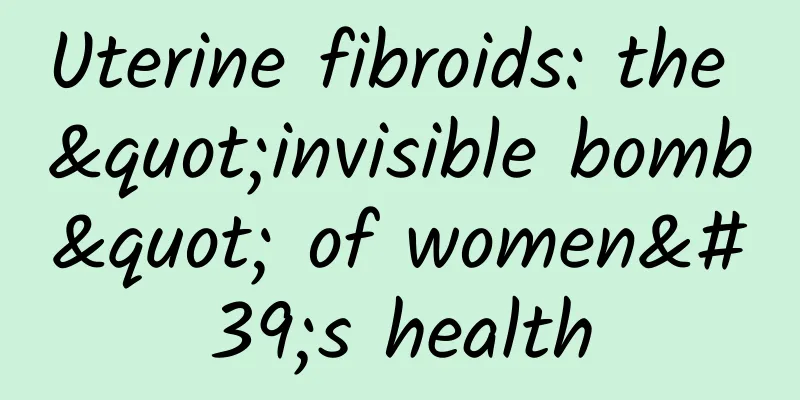Uterine fibroids: the "invisible bomb" of women's health

|
The uterus is an important organ in the female reproductive system. It not only breeds new life, but also is an important place for the secretion of female hormones. But sometimes, this important organ may encounter an "invader" - uterine fibroids. This "invisible bomb" hidden in the uterus may pose a great threat to women's health. So, what exactly is uterine fibroids? How does it affect our health? Let's unveil its mystery together. 1. Overview of uterine fibroids Uterine fibroids, as the name suggests, are benign tumors that grow in the uterus. They are one of the most common gynecological tumors in women and are composed of smooth muscle and connective tissue. Although most uterine fibroids are asymptomatic, some may cause symptoms such as irregular menstruation, dysmenorrhea, abdominal discomfort, and in severe cases may even lead to infertility. 2. Causes of uterine fibroids The exact cause of uterine fibroids is not fully understood, but it is generally believed to be related to female hormone levels. Estrogen, in particular, is believed to play an important role in the development of uterine fibroids. In addition, genetics, inflammation and other factors may also increase the risk of uterine fibroids. Symptoms and diagnosis of uterine fibroids Although most uterine fibroids are asymptomatic, some women may experience symptoms such as heavy menstrual bleeding, painful menstruation, and abdominal bloating or discomfort. If you experience these symptoms, it is recommended that you see your doctor for diagnosis. Doctors usually diagnose uterine fibroids through a pelvic exam, ultrasound, or hysteroscopy. 4. Treatment of uterine fibroids The method of treating uterine fibroids depends on the size, location and severity of the symptoms of the fibroids. Treatment methods include watchful waiting, drug therapy and surgical treatment. Watchful waiting is suitable for asymptomatic fibroids, while drug therapy is mainly used to relieve symptoms and inhibit the growth of fibroids. Surgical treatment includes myomectomy and hysterectomy. The specific method needs to be determined by the doctor based on the specific situation of the patient. In recent years, with the advancement of medical technology, minimally invasive surgery has become the main means of treating uterine fibroids. It has the characteristics of less trauma and faster recovery. At the same time, doctors will also develop personalized treatment plans based on factors such as the patient's age and fertility needs to protect the patient's physical and mental health to the greatest extent. 5. Prevention and health care of uterine fibroids Although there is no definite way to prevent the occurrence of uterine fibroids, maintaining a healthy lifestyle can help reduce the risk. This includes maintaining moderate exercise, a balanced diet, and avoiding long-term mental stress. At the same time, regular gynecological examinations are also an important means of early detection and diagnosis of uterine fibroids. For women who have been diagnosed with uterine fibroids, in addition to accepting the doctor's treatment advice, they should also maintain a good attitude and actively cooperate with the treatment to obtain the best treatment effect. Conclusion Uterine fibroids are a common disease in the female reproductive system. Although they do not pose a threat to health in most cases, they may also have serious effects in some cases. Understanding the causes, symptoms, diagnosis, treatment and prevention methods of uterine fibroids can help us pay more attention to our health and detect and deal with problems in a timely manner. At the same time, we also hope that every woman can care for her body, maintain a healthy lifestyle, and stay away from the troubles of diseases. In the face of challenges such as uterine fibroids, let us join hands with the power of science to protect our health and happiness together! |
<<: Lymphoma: The battle on the body's "hidden front"
>>: Non-small cell lung cancer: a protracted battle against "smog"
Recommend
What to eat when you have a stomachache during menstruation
Menstruation is a normal physiological phenomenon...
Pain in the buttocks after giving birth
In fact, giving birth can cause great harm to the...
What are the symptoms of sexually transmitted diseases in women
In the traditional sense, sexually transmitted di...
"Eat for Health" Special Series | Feeling a little anxious? Why not eat something "sour"!
Do you feel anxious? Some young people often suff...
What causes dry mouth in pregnant women and how to relieve it
When a woman is pregnant, she is happy, but many ...
What is the meaning of Zero Dragon Tower?
What does Zero Dragon Tower mean? Recently in LOL...
Don’t confuse “vision” and “field of vision”
The ability of the eyes to distinguish the image ...
What are some ways for girls to exercise?
Girls are generally lazy. In our country, female ...
What is the best time to take oral contraceptives?
Oral contraceptives are one of the commonly used ...
How long does it take for an airplane to circle the earth? Why is there a layer close to the earth's surface?
The Earth is the largest terrestrial planet in th...
How long is the best time for pregnant women to bask in the sun?
When a woman is pregnant, the levels of progester...
40 weeks plus 4 days of abdominal pain
Mothers carry their babies for ten months before ...
Peach gum = cheap bird's nest? Is it really that magical?
In the spring, peach blossoms bloomed quietly, pe...
Can a fetus with rhabdomyomas give birth?
Generally speaking, most fetal rhabdomyomas are b...
What to do if one breast is larger than the other
I believe everyone knows the role of breasts for ...
![[Not So Safe] The Dance of Alcohol and Drugs - A Dangerous Encounter](/upload/images/67f16e7156e2f.webp)








